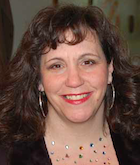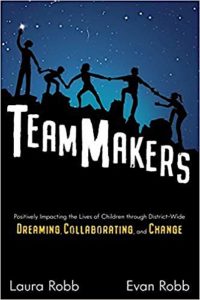It’s Time for Districtwide Teaming and Dreaming
Team Makers: Positively Impacting the Lives of Children through District-Wide Dreaming, Collaborating, and Change
By Laura Robb and Evan Robb
(Dave Burgess Consulting, 2019 – Learn more)

When Laura Robb or Evan Robb talk, it’s a good idea to listen. This mother-son team has a deep well of experience and expertise to draw from, and they share it with fellow educators in a kind, common sense, and joyful manner. If you don’t already follow both on Twitter, you’ll want to do that to. It’s worth it. I promise.

Think about the title: Team Makers. Those two words sum up the book well – it’s about working collaboratively to make the schools we want and the learning experience students deserve.
I love this message. Education is not a do-it-yourself endeavor. Being part of a profession means using institutional knowledge to guide daily decisions. Laura and Evan get this, and further, they say it’s time to update our institutional knowledge to reflect a new age where critical thinking, voice and choice, and growth-focus are king. Inspired yet?
Five Parts Aimed at “Big Dreams”
The book is divided into five parts. Each aims to help readers make sure their “Dreams are big enough” (back cover) to transform education from the ordinary to the extraordinary. Further, the book offers a “roadmap for effective dreaming, and planning” such that readers see “no limit to what schools can achieve on behalf of students.”
Within each part are three to four chapters chock full of information shared in the form of stories from Team Robb’s work in the field. Additionally, there are “interludes” – short anecdotes related to the theme and written by active educators. Each chapter closes with questions that serve as invitations to discuss, reflect, and revisit the content. Here’s a summary of each part.
Part I: Looking Backward to Move Forward
Here the authors make the case for a new growth-focused mindset for schools that includes building and maintaining strong teams. Readers are encouraged to dream big but to remember that “All shifts gain depth and staying power when the journey is slow and steady” (p. 9). Additionally, they share the notion that if we want positive, sustainable change, all stakeholders, from superintendent to the students themselves, must be part of the team.
Most importantly, Robb and Robb say that districts and schools must use the power of teams to cultivate a collective sense of efficacy. They write, “When more and more people in a school district have strong self-efficacy, collective efficacy develops. In turn, the positive energy released by collective efficacy can transform schools; problems and challenges into changes benefiting all stakeholders, especially children” (p. 15).
Part II: Examining and Reimagining
These chapters build on the groundwork of Part I. Once we’ve got our big dreams in place, it’s time to start examining our current practices and reimagining them to help us make our dreams come true. Laura and Evan start by offering a list of practices to abandon, most having to do with old-fashioned school models, in favor of more collaborative ones. For example, they say to get rid of traditional seating to make learning spaces more conducive to working in teams. Another example is letting go of one-size-fits-all instruction in favor of differentiation.
Further, they extend on the notions of efficacy and agency such that schools are places where anyone can initiate positive change. They talk specifically about a new vision for leadership, saying “Traditional leadership roles should be redefined by risk-taking and creative thinking” (p. 37) and encouraging leaders to get out of their offices and into classrooms as often as possible.
Part III: Becoming a Community of Problem Solvers
In Part III, you’ll find information, ideas, and stories about building strong and supportive communities district-wide. The authors concentrate on communication, coaching, mentoring, and a shift away from teacher-focused thinking to a student focus.
Particularly refreshing is the discussion on how relationship building is key to success at all levels. They write, “Teachers who put children first and continually work to nurture positive connections with each student understand that trusting relationships positively affect how children learn, listen, and interact with their teacher and their peers” (p. 76).
While that message in and of itself may not sound new, the twist that I loved is that they apply every word of that quote to district leaders’ interactions with principals and principals’ interaction with teachers.
Part IV: Changing Mindsets Through Professional Learning
Professional learning is a pillar on which excellent schools stand. Laura and Evan bring the topic of collective efficacy back to the conversation and share how helping educators tap into the power of professional development in many forms can invigorate teaching, especially when the way we participate in it mirrors what we want from our students.
They write: “We recommend that teachers learn in ways they will teach their students, firmly believing that by experiencing collaboration, student-led discussions, choice, and project-based learning, etc., teachers will be prepared to bring these practices to their students” (p. 91).
Flipped staff meetings, differentiated professional development, choice-based growth plans, and goal-setting are all discussed in regard to both educator and student learning.
Part V: Walking the Tightrope of Change
This last part of the book ties the whole shebang together: “We hope to inspire you to collaborate, communicate, and become the TeamMakers who can and will affect the changes needed in schools” (p. 119). Further, the authors urge readers to adopt an open and questioning mindset whereby educators continually examine processes and problems and are open to change.
My favorite section in Part V is on “branding” classrooms, schools, and districts. I love the notion of helping shape a school through positive advertising and streamlining visions and missions so that they become indelibly ingrained in our thoughts. I wrote about branding for MiddleWeb here, and it’s wonderful to see Robb and Robb (titans in the field) on the same page.
Team Makers to Make Your Teams Better
I really enjoyed this book and recommend it without hesitation. While I think that almost any educator would find value in reading it, it is a must for school leaders (and aspirants) of all types. As a working principal, Team Makers helped me reflect on many big questions, including:
- What are my big dreams for my school?
- Where are we in relation to those dreams?
- Is the climate of my school strong and positive enough to carry the dreams?
- What types of teams are strong at my school? What types might need strengthening?
- Are my principal “boots” on the ground often enough? Am I still in touch?
- What is the state of the learner-mindset among staff? How are we helping each other grow?
- How are we encouraging student agency?
- Am I sharing leadership? How can I further extend the invitation to lead?
In you find yourself interested in any of these questions through a classroom, school, or district lens, get a copy of Team Makers: Positively Impacting the Lives of Children through District-Wide Dreaming, Collaborating, and Change. The thinking each chapter spurs will lead you to find answers that will help you make your best school dreams come true.
Rita Platt (@ritaplatt) is a National Board Certified Teacher with master’s degrees in reading, library, and leadership. Her experience includes teaching learners in remote Alaskan villages, inner cities, and rural communities. She currently is a school principal, teaches graduate courses for the Professional Development Institute and blogs at Heart of the School for MiddleWeb. Her book, Working Hard, Working Happy: Cultivating a Culture of Effort and Joy in the Classroom, launched in early July.






























